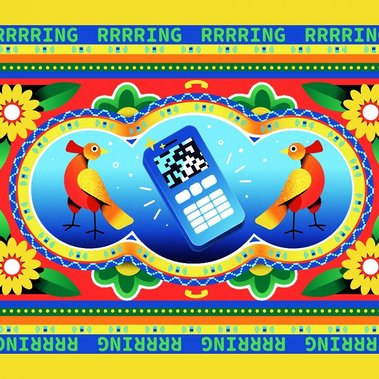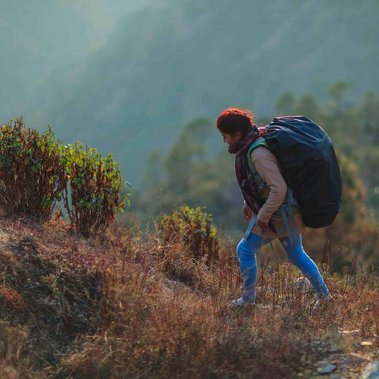selected work
Don’t pick up! The rise and fall of a massive industry based on missed calls
At a time when less than a tenth of India’s population was online — smartphones were prohibitively expensive, and buying a gigabyte of mobile data, which was glitchy and agonizingly slow outside of major cities, cost the average rural Indian two to three days’ wages — missed calls made information from an otherwise unreachable digital world available with a single dial. Users needed only a feature phone: the kind with a number pad, preloaded with a game of Snake. “For many people, ZipDial was the first connection to the internet,” says Sanjay Swamy, one of the company’s founders and board members.
(Photo: Birgit Palma and Daniel Triendl)
The cost of conscience
Himal Southasian
From these indignities greater wealth and power promise relief, and most importantly respect. Small wonder then that there’s a frenzied desire, at a time when class boundaries have become seemingly permeable, to seize this better life. Even PT Sir, whose circumstances as a lower-middle-class schoolteacher are by no means desperate, craves power, disaffected as he is with the stultifying routines of his life and the emasculation he feels as the only man at a girls’ school. One day as he’s returning home on a crowded train after stumbling into a Jana Kalyan rally, PT Sir is mistaken for a party member and handed a complimentary bowl of muri. Majumdar describes here the beginnings of an ambition he will try to realise in the rest of the novel: “PT Sir feels the other passengers staring at him. They must be thinking, who is this VIP?”
(Photo: Al Jazeera English / Flickr)
Storeyed Past
The Caravan Magazine
ON A SUNDAY MORNING LAST OCTOBER, in a cramped office overlooking Kathmandu Durbar Square—an iconic plaza surrounding Nepal’s old royal palace—a small group of volunteers was frantically preparing for a public exhibition to be held that afternoon. The subject of the event was the reconstruction of Kasthamandap, a giant pagoda-like building that gave Kathmandu its name, and which, for more than a thousand years—until it collapsed in an earthquake in 2015—had been a public fixture, sheltering ascetics, weary traders, and on occasion, men exiled from their homes for the night by their irate wives. The office had the chaotic air of a crafts fair. People rushed around wielding scissors, stepping over paper scraps, glue-bottle caps and chunks of styrofoam. At one end, nine volunteers pieced together a 3D paper-model of the plaza outside.
(Photo: Narendra Shrestha/EPA)
Why Nepal Once Led the World in Electric Buses
CityLab/The Atlantic
If you take public transport in Kathmandu, you have three options. There are buses and microbuses, different only in size. During rush hour in Nepal’s capital, both are often crammed to almost twice their stated capacity and on the prowl for more passengers. Both feature gruff conductors who hang off the vehicles like they’re heeling sailboats, crying out a string of bus stops so fast the names blur into each other. As the buses slow down, the conductors slide open their doors and hustle people inside, in scenes reminiscent of drive-by kidnappings.
The third option, Safa Tempos (literally, “clean three-wheelers”), stand apart from the fray. They lack conductors, for one, and many are driven by women, an otherwise uncommon sight. They look like large, white tin boxes, with benches to seat 12 people and an open entrance at the back. And they’re battery-powered.
(Photo: Niranjan Shrestha/AP)
The Hikers Bringing Contraception to Remote Villages in Nepal
Outside Magazine
(This piece was an Editor's pick at Longreads.com)
One morning last winter in a village in Baitadi, a district in far-west Nepal, Kabita Bhandari sat down with a group of women to dispel local rumors about long-term contraceptives. Bhandari is 22 years old, an auxiliary nurse, a mother of a two-year-old girl, and an employee at the reproductive-health agency Marie Stopes International. Earlier that day, she had arrived in Siddhapur from Patan, the capital of Baitadi, which, like the rest of this midhills region of Nepal, has few roads and is notoriously difficult to supply with modern services. As one of its six visiting service providers (VSPs), Bhandari completes a two-week circuit across the district every month, navigating steep, treacherous trails to administer long-term contraceptives to women in far-flung villages. This was her first stop.
(Photo: UNFPA Nepal/Laxmi Prasad Ngakhusi)
India and Nepal: A Tale of Two Maps
The Juggernaut
Last November, when the Indian government released its new map, the world was focused on Kashmir. That prior August, India had demoted and split the state of Jammu and Kashmir into two union territories; the new map ostensibly cemented that change. But in Nepal, the map became a target of furious criticism for another feature: India’s continued inclusion of Kalapani, a 14-square-mile strip of land that lies in a tri-junction area between Nepal, India, and China — an area that Nepal has long claimed as its own.
Protests broke out in Kathmandu accusing India of “illegally occupying” land. Nepal’s foreign ministry stated that Kalapani was a part of Nepal. India’s external ministry disputed the claim. Despite the furor, Nepal had reportedly sent diplomatic overtures to the Indian government.
(Photo: India Prime Minister’s Office)
Burning Resentment
The Caravan Magazine
“We’ve worked here so fucking long, they should give us an award, send us off with flowers and five or seven lakhs,” Gyan Bahadur Acharya told me one morning last January. We were inside the premises of the Pashupatinath temple in Kathmandu, and Acharya, a slight, scowling man, was sitting cross-legged near the steps of the Bhasmeshwor ghat. On a row of raised stone platforms in front of us, bodies burned on wooden funeral pyres. Tending to them were cremators in white dhotis, many of them Acharya’s protégés. One lobbed packets of vegetable oil into a fire, followed by bundles of straw; another, using a long bamboo pole, gently reversed the course of a blackened foot that had drifted from the rest of the body.
(Photo: Narayan Maharjan/Getty)
In post-quake rebuilding, Kathmandu's carvers reclaim a fading heritage
CS Monitor
(This piece won the 2018 "Outstanding Arts & Culture Reporting on South Asia" award from SAJA – the South Asian Journalists Association)
PATAN, NEPAL — In a workshop inside the courtyard of a 17th century palace, Tirtha Ram Shilpakar is surrounded by the guts of ancient temples. The floor around him is crowded with carved wooden beams, ashy with age. The walls are lined with pillars and detached windows. A few steps off lies an 11-ft.-wide doorway, dissected on the floor.
Tirtha Ram sits hunched in a corner, one leg curled over a giant beam. Amid the scream of power saws and the blare of '80s Bollywood hits, he carves into the beam, hammer and chisel in hand, copying a floral pattern from a sketch beside him.
(Photo: Gemunu Amarasinghe/AP)
The man who wants to “democratize” AI
Rest of World
In the late ’90s, when Sameer Maskey was a college student, artificial intelligence was an esoteric field. Yet Maskey, who “fell in love with computers” during his freshman year at Bates College, took an immediate interest in AI, particularly the idea of speech-to-speech translation. In 2000, after research stints at Carnegie Mellon and the California Institute of Technology, he built the first Nepali speech synthesizer and released it open source at a conference in Nepal. Back then, “nobody took any interest,” says Maskey. “Not many people were talking about AI in Nepal.”
Today, Maskey is the founder and CEO of Fusemachines, a company that creates AI tools and provides teams of engineers to businesses in the US that want to build their own. Quiet and driven, he has converted his years of research and teaching — as a PhD from Columbia University, a speech-to-speech-translation research scientist at IBM Watson, and an assistant adjunct professor at Columbia — into the foundation for a 250-person company.
(Illustration: Nigel Buchanan)








